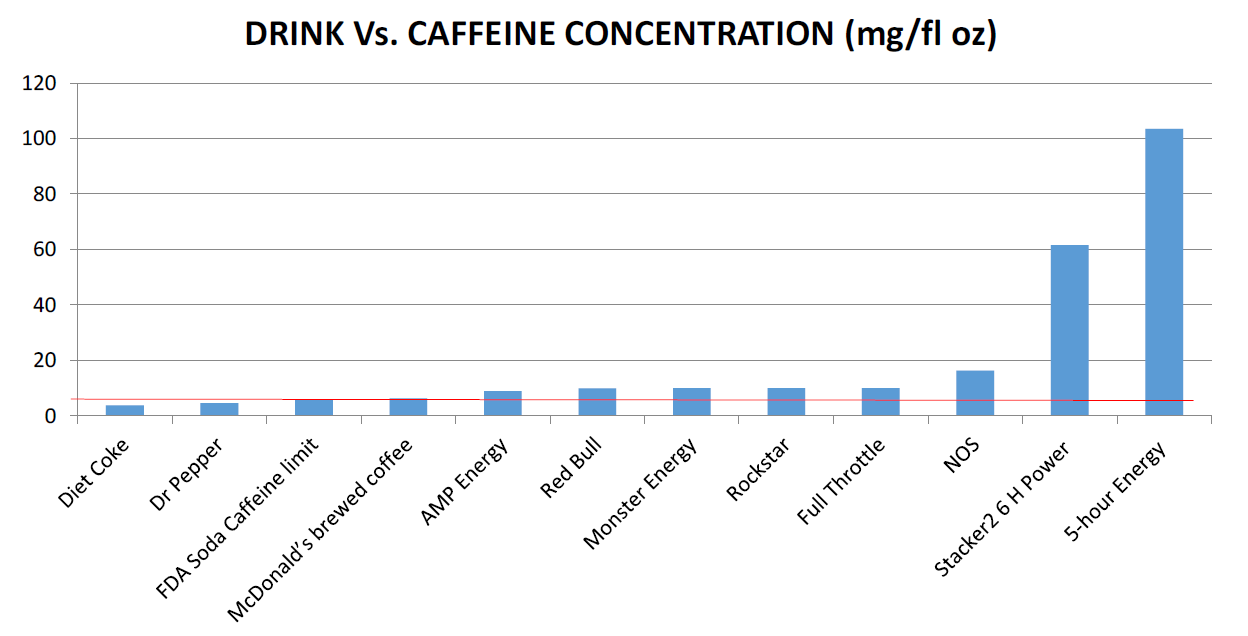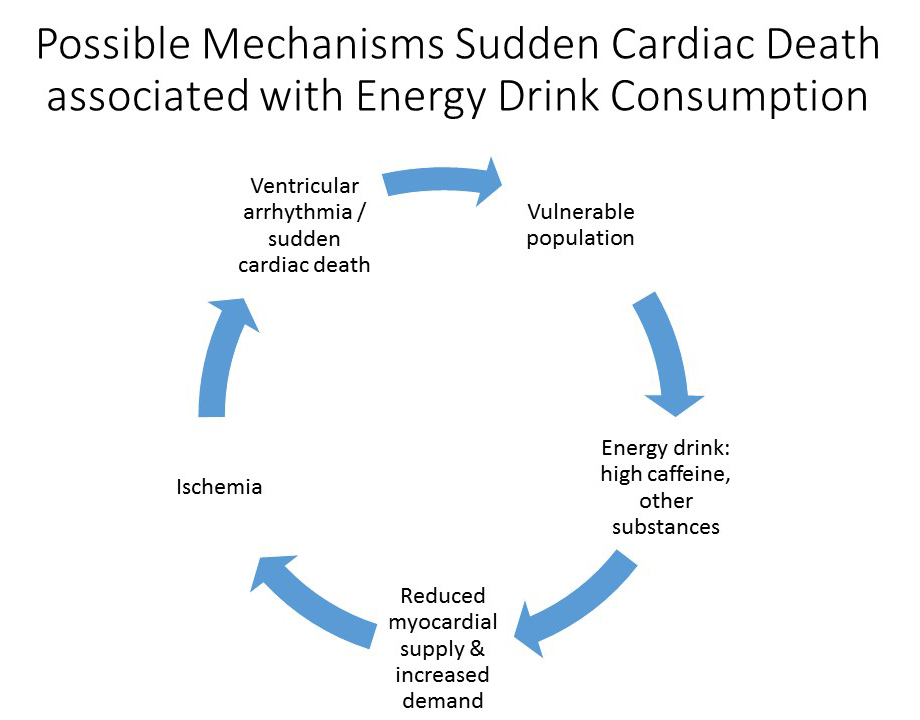Stimulant-Containing Energy Drinks
Introduction
Energy drinks are frequently consumed by athletes, weekend warriors, service members, college students, secondary school students, and are heavily marketed to children and adolescents.4,11,15 Marketed for and used to boost performance, they often have high concentrations of caffeine and other stimulants that can cause serious side effects.
The scientific community, media, governments, athletic departments and the general public have expressed safety concerns over energy drinks specifically for vulnerable populations, including those:4,6
- under 18 years of age
- caffeine-naïve or caffeine-sensitive
- pregnant or breastfeeding women
- taking stimulants or other caffeine-based medications
- with comorbid cardiovascular or other medical conditions.
Energy drinks and shots are unique in that the caffeine concentration is comparatively higher than other caffeinated beverages, such as sodas, which are subject to a limit imposed by the FDA (Figure 1). In addition, compared to adults, younger teens generally have limited tolerance to caffeine due to infrequent consumption. Thus, youthful athletes are more subject to adverse effects, particularly when consuming large and rapid doses of caffeine present in energy drinks in combination with exercising around the same time.9
Figure 1
Energy Drink Ingredients
Caffeine is a core ingredient in energy drinks and is rapidly and completely absorbed, peaking in concentration in approximately 30-120 minutes post-ingestion.16 When added to energy drinks, caffeine is typically a synthetic alkaloid rather than a naturally-occurring constituent of plant based beverages (e.g., tea or coffee). However, guarana and yerba mate, which can be contained as part of the energy blend of energy drinks, are also natural and an additional source of caffeine in these products. As such, the total amount of caffeine in energy drinks may not be accurately reflected on the label. Importantly, levels of caffeine in energy drinks vary between 71-316 mg of caffeine per 8 oz. serving, which exceeds the FDA-imposed limit of 71 mg of caffeine per 12 fluid oz. of soda.11 In addition, energy drinks frequently include significant amounts of carbohydrates (usually glucose), taurine (an amino acid), niacin, pyridoxine, cyanocobalamin (B12), riboflavin (B2), ginseng extract, glucuronolactone (a glucose metabolite), inositol (B8), guarana (contains caffeine, theobromine, and theophylline), ephedra, Yohimbine, gingko, kola nut, theophylline, vitamins, herbs, and/or L-carnitine.3 The health effects of these additives are not well documented.7
Energy Drinks and Performance
The caffeine contained in energy drinks has ergogenic potential, with doses of pure caffeine of 3-6 mg per kilogram of body weight associated with an increase in power and aerobic activity (e.g., split times) by approximately 4%.14 However, the evidence for energy drinks as "performance-enhancing" is mixed. With respect to improving aerobic/anaerobic performance and/or reaction time after energy drink consumption, studies are inconsistent.9 Several studies have reported improved endurance or muscle performance; however, others demonstrate no benefits, with some documenting a negative effect as evidenced by increased muscle fatigue and reduced cerebral blood flow.9-11
Adverse Effects of Energy Drink Use
In 2011, there were 4,854 logged calls to US Poison Control Centers regarding adverse energy drink exposures, most deemed secondary to their caffeine and stimulant toxicity.13
The cardiac adverse events associated with acute energy drink consumption are likely related to increased heart rate and blood pressure, together with changes in conduction system associated with acute consumption of energy drinks, and include tachycardia, hypertension, supra- and ventricular arrhythmias, STEMI, aortic dissection and others shown in Figure 2.5,9 Possible side effects from long term use are shown in Figure 2. Other adverse effects associated with energy drink consumption include epileptic seizures, stroke, subarachnoid hemorrhage, pontine myelinolysis, hallucinations, anxiety, agitation, headaches, hepatitis, gastrointestinal upset, acute renal failure, rhabdomyolysis, metabolic acidosis, insulin resistance, obesity, acute psychosis, insomnia, high risk/aggressive behavior and caffeine withdrawal.8,11,12,16
Figure 2
Cases of sudden cardiac death after energy drink use have been reported, yet assigning causation is difficult9,11 A possible mechanism underlying sudden cardiac death associated with energy drink consumption and exercise may include a supply-demand imbalance as detailed in Figure 3.
Figure 3
Recommendations
Energy drinks should not be:1-4,8,9,11,16
- Consumed by children or adolescents: cases of children who have developed cardiac arrhythmias, psychiatric symptoms, as well as sudden cardiac death in association with consumption of energy drinks have been reported. One case involved a 17-year-old male who had severe coronary artery spasm in association with energy drink consumption with a resulting STEMI on ECG and significantly elevated cardiac troponin. Another involved a 14-year-old girl who died after drinking two energy drinks; an autopsy concluded she died of cardiac arrhythmia due to caffeine toxicity
- Used for hydration prior to, during, or after physical activity: our research suggests an impairment in endothelial function in the hours following consumption of energy drinks, which could result in impairment in blood flow to the heart and other vital organs and complications.
- Marketed to or consumed by vulnerable populations: cases where such individuals who have consumed energy drinks and had associated complications have been described; e.g., a 13-year-old boy who had a coronary artery dissection in association with consumption of an energy drink.
- Consumed with alcohol: binge drinking of energy beverages combined with alcohol is common practice, resulting in the "toxic wide-awake drunk" who despite being impaired by the alcohol is wired from the energy drink and has a false sense of confidence in their abilities, which may lead to risk taking and dangerous behavior.
- Consumed close to bedtime: caffeine has a half-life of 4-6 hours and will interfere with restful sleep in most who consume it within an hours prior to bed.
Health care providers, trainers, coaches, and parents and children should be educated about potential adverse events associated with energy drink use.
Conclusions
Energy drinks are frequently consumed by young athletes and there are reports of morbidity and mortality associated with consumption. In particular, susceptible individuals include younger, smaller, caffeine-naïve/sensitive, pregnant or breastfeeding women and those with underlying medical conditions. While most healthy adults can consume a single energy drink without any significant negative acute health effects, the long-term effects of chronic consumption have not been well studied.
References
- Seifert SM, Schaechter JL, Hershorin ER, Lipshultz SE. Health effects of energy drinks on children, adolescents, and young adults. Pediatrics 2011;127:511-28.
- Committee on Nutrition and the Council on Sports Medicine and Fitness. Sports drinks and energy drinks for children and adolescents: are they appropriate? Pediatrics 2011;127:1182-9.
- National Federation of State High School Associations, Sports Medicine Advisory Committee. Position statement and recommendations for the use of energy drinks by young athletes. https://www.nfhs.org/media/1014749/nfhs-smac-position-statement-for-use-of-energy-drinks-october-2014.pdf. [Accessed 13 May 2016]
- Al-Shaar L, Vercammen K, Lu C, Richardson S, Tamez M, Mattei J. Health effects and public health concerns of energy drink consumption in the United States: a mini-review. Front Public Health 2017;5:225.
- Berger AJ, Alford K. Cardiac arrest in a young man following excess consumption of caffeinated "energy drinks." Med J Aust 2009;190:41-3.
- Breda JJ, Whiting SH, Encarnacao R, et al. Energy drink consumption in Europe: a review of the risks, adverse health effects, and policy options to respond. Front Public Health 2014;2:134.
- Higgins JP, Ortiz BL. Energy drink ingredients and their effect on endothelial function: a review. Int J Clin Cardiol 2014;1:1-6.
- Higgins JP, Tuttle TD, Higgins CL. Energy beverages: content and safety. Mayo Clin Proc 2010;85:1033-41.
- Higgins JP, Yarlagadda S, Yang B. Cardiovascular complications of energy drinks. Beverages 2015;1:104-26.
- Jeffries O, Hill J, Patterson SD, Waldron M. Energy drink doses of caffeine and taurine have a null or negative effect on sprint performance. J Strength Cond Res 2017. [Epub ahead of print]
- Manchester J, Eshel I, Marion DW. The benefits and risks of energy drinks in young adults and military service members. Mil Med 2017;182:e1726-33.
- McKetin R, Coen A, Kaye S. A comprehensive review of the effects of mixing caffeinated energy drinks with alcohol. Drug Alcohol Depend 2015;151:15-30.
- Seifert SM, Seifert SA, Schaechter JL, et al. An analysis of energy-drink toxicity in the National Poison Data System. Clin Toxicol 2013;51:566-74.
- Shearer J, Graham TE. Performance effects and metabolic consequences of caffeine and caffeinated energy drink consumption on glucose disposal. Nutr Rev 2014;72:121-36.
- Terry-McElrath YM, O'Malley PM, Johnston LD. Energy drinks, soft drinks, and substance use among United States secondary school students. J Addict Med 2014;8:6-13.
- Turnball D, Rodricks JV, Mariano GF, Chowdhury F. Caffeine and cardiovascular health. Regul Toxicol Pharmacol 2017;89:165-85.
Keywords: Caffeine, Energy Drinks, Theobromine, Paullinia, Theophylline, Coffee, Ilex paraguariensis, Pyridoxine, Aldehyde Dehydrogenase, Ginkgo biloba, Niacin, Taurine, Blood Pressure, Athletes, Carnitine, Yohimbine, Reaction Time, Insulin Resistance, Glucose, Inositol, Poison Control Centers, Vulnerable Populations, Myocardial Infarction, Coronary Vessels, Heart Rate, Sleep Initiation and Maintenance Disorders, Subarachnoid Hemorrhage, Glucuronates, Central Nervous System Stimulants, Arrhythmias, Cardiac, Sports, Death, Sudden, Cardiac, Cerebrovascular Circulation, Tachycardia, Hypertension, Stroke, Dangerous Behavior, Amino Acids, Health Personnel, Aneurysm, Dissecting, Acidosis, Seizures, Risk-Taking, Hepatitis, Acute Kidney Injury, Rhabdomyolysis, Riboflavin, Troponin, Ephedra, Electrocardiography, Athletes, Pediatrics
< Back to Listings



